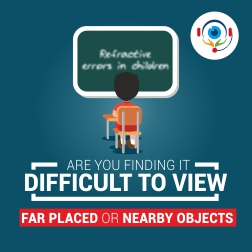Refractive Errors in Childhood
What is a Refractive Error?
A Refractive Error is a very common eye disorder that takes place when the eye is not able to focus on images causing your vision to become blurry. There are various refractive errors and these include -
1. Myopia (Nearsightedness)
In Myopia an image of an object kept at a distance becomes focused in front of the retina. The most common among the types of refractive errors, myopia enables distant objects to appear out of focus.
2. Hyperopia (Farsightedness)
In Hyperopia the image of a near-distanced object becomes focused behind the retina and objects that are close remain out of focus.
3. Astigmatism
Two focal points fall in two different areas because of the abnormal curvature of the cornea in Astigmatism. Due to this, objects sitting at a close distance and the ones placed farther away appear blurry. Astigmatism may be combined with myopia (nearsightedness) or hyperopia (farsightedness).
Causes
When the shape of the eye prevents light from focusing directly on the retina it leads to a refractive error. Length of the eyeball (too long or too short), changes in the shape of the cornea and aging are some factors that cause a refractive error.
Myopia takes place either because the eyeball axis is too long or on account of the refractive power of the eye being too strong. It causes headaches and/or eye strain.
Hyperopia takes place either because of the eyeball axis being too short or because the refractive power of the eye is too weak. Headaches, eye strain and fatigue are caused due to hyperopia. A child with hyperopia squints, rubs their eyes, displays a decreased interest in school or has trouble reading.
Astigmatism takes place because of the abnormal curvature of the cornea and causes headaches, eye strain and fatigue. Children with astigmatism often engage in eye rubbing, show a lack of interest in school and experience a difficulty in reading.
What are the Symptoms of Refractive Errors?
Apart from the symptoms mentioned above, here are some other symptoms you must watch out for in your child -
1. Holding objects too close to the eyes
2. Clumsy Movement
3. Does not notice things happening at a distance
4. Sitting extremely close to the television set while watching a programme
5. Constantly making mistakes while taking down notes during class
6. Constant eye squeezing while sitting in front of digital devices, television or the computer
Diagnosis for Refractive Errors
Refractive errors are diagnosed through an eye examination. To prevent the eye from focusing and compensating for the optical error, dilating eye drops is used. In doing so, the optical power of the eye is measured in diopters (a unit of refractive power).
Preventions
A refractive error cannot be prevented. But through early detection and treatment your childi's vision can get corrected.
Treatments
To treat refractive errors the doctor will prescribe corrective lenses in glasses, contact lenses or refractive surgery depending on the kind of refractive error.
Takeaway
Your vision develops in the first few years after birth. If your child has a refractive error, it's always better to get it detected and treated at an early age. Otherwise, your child will suffer severe consequences.



